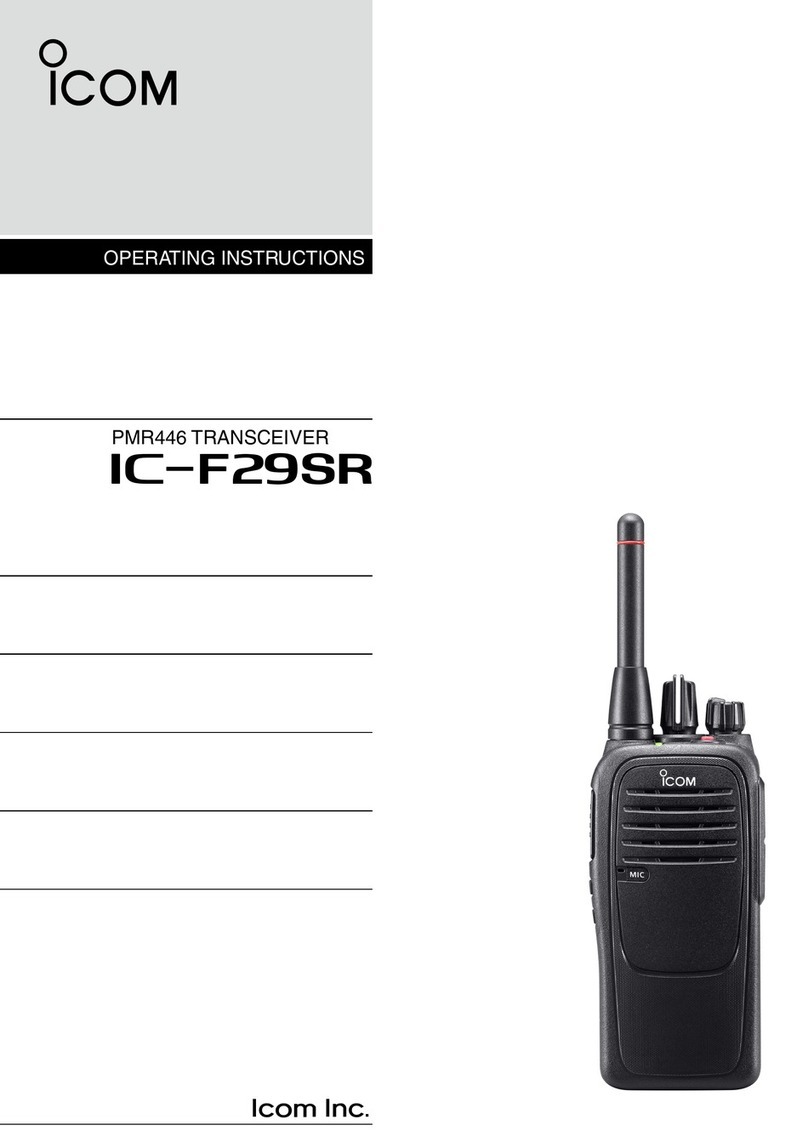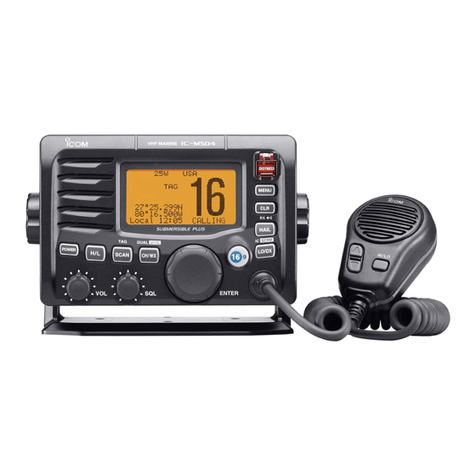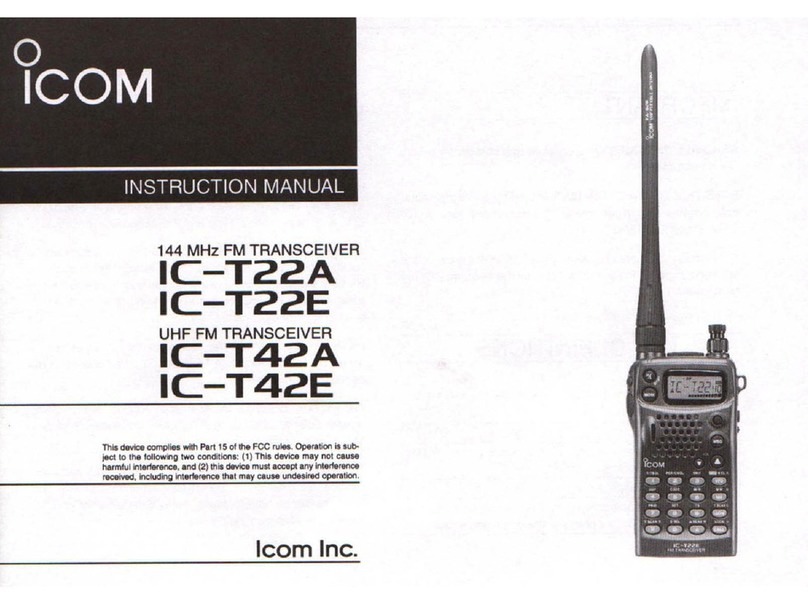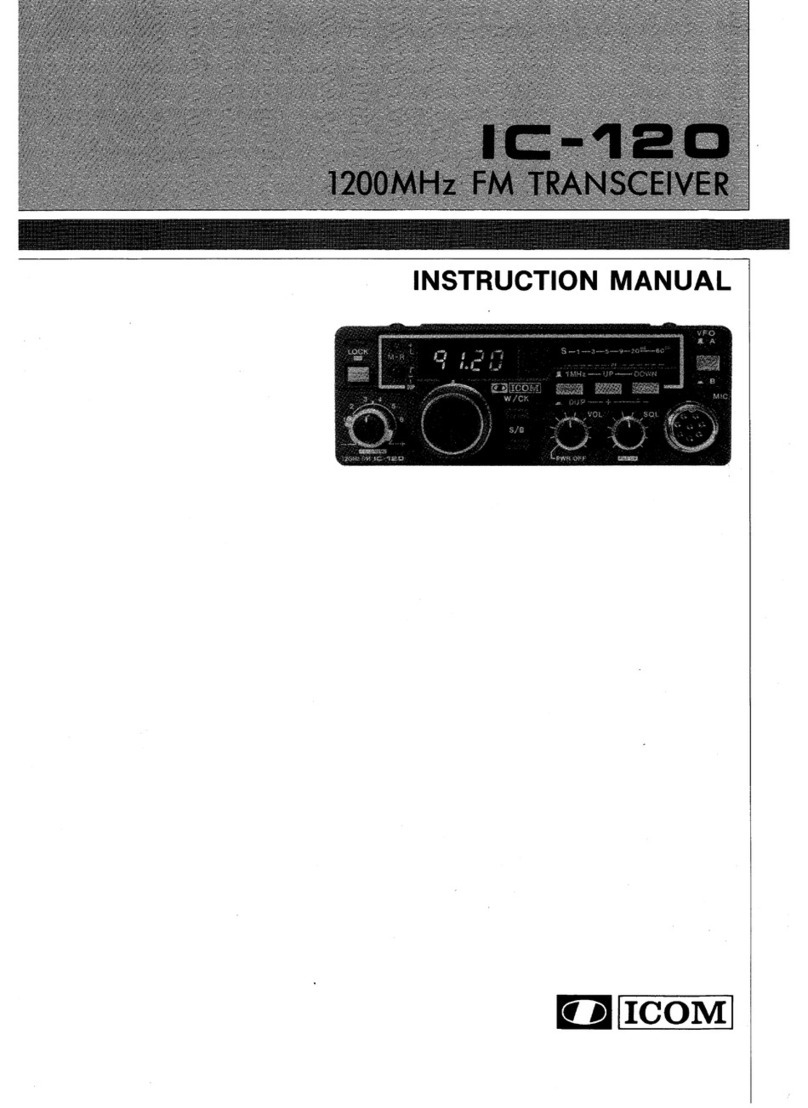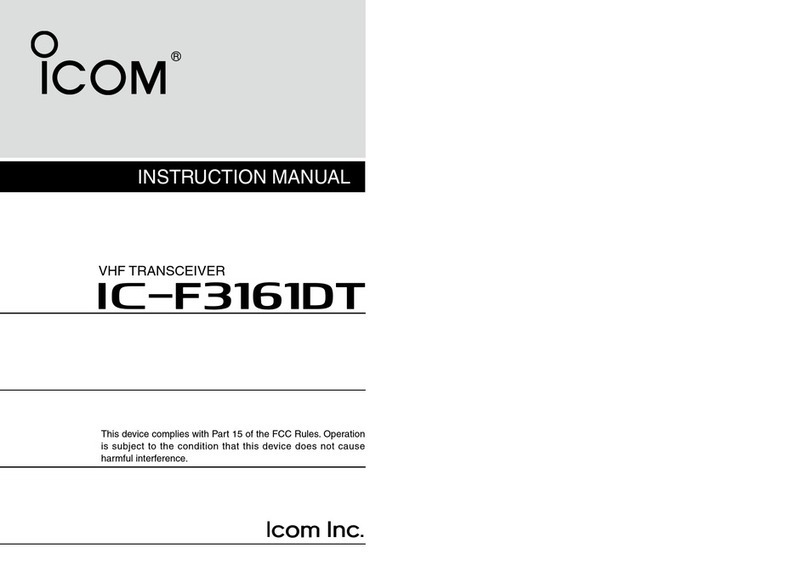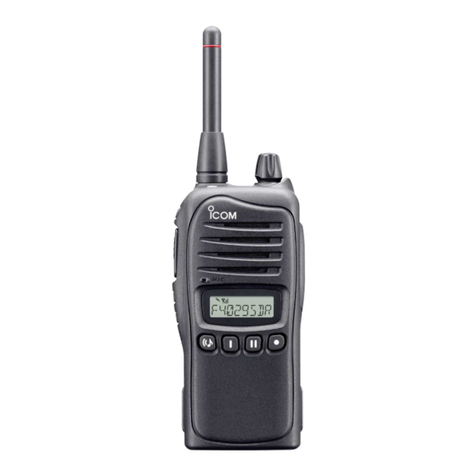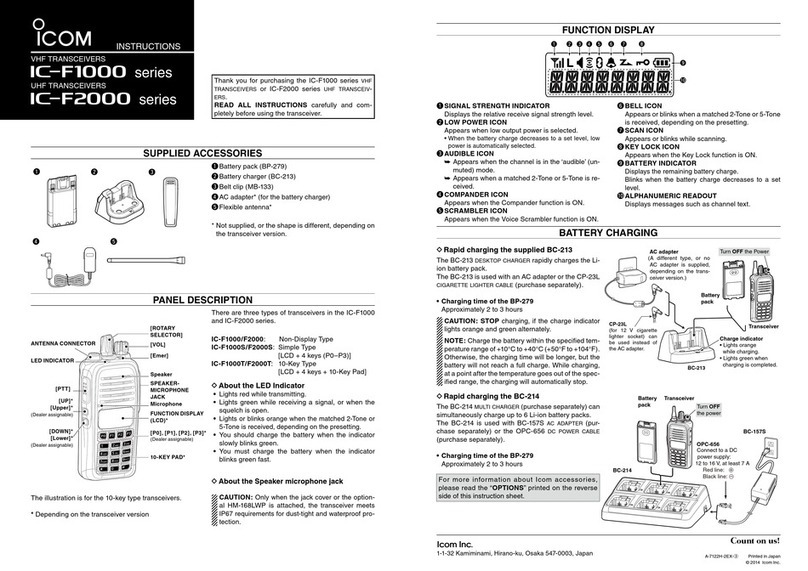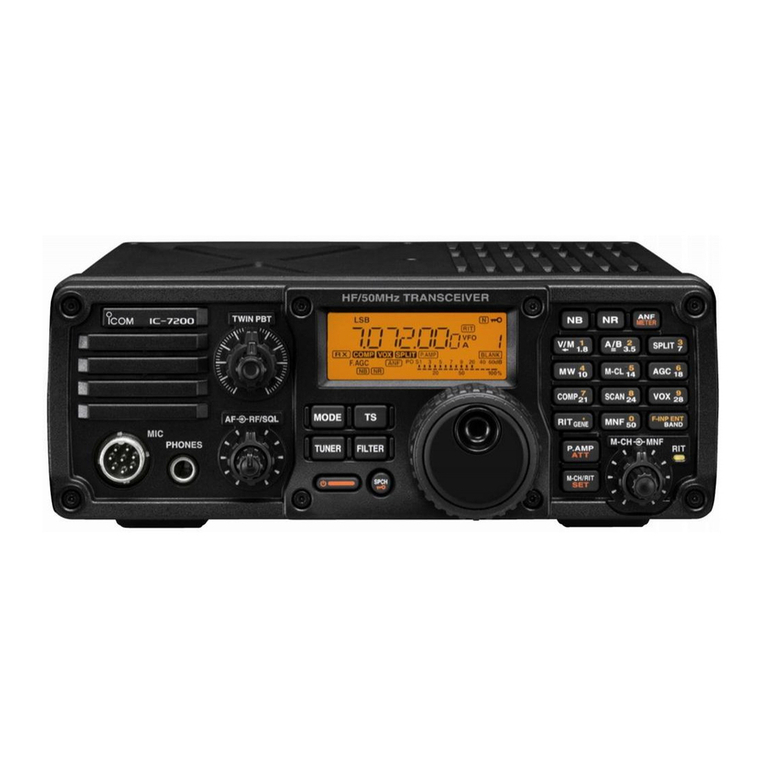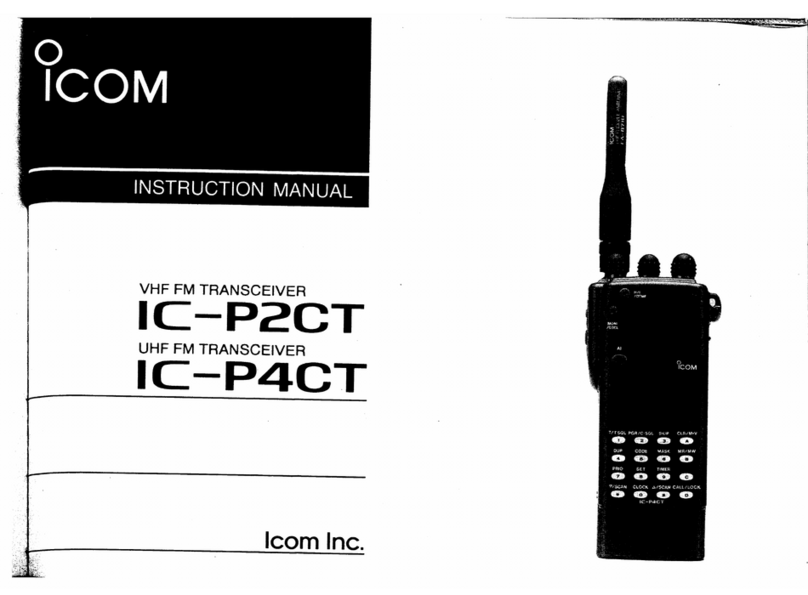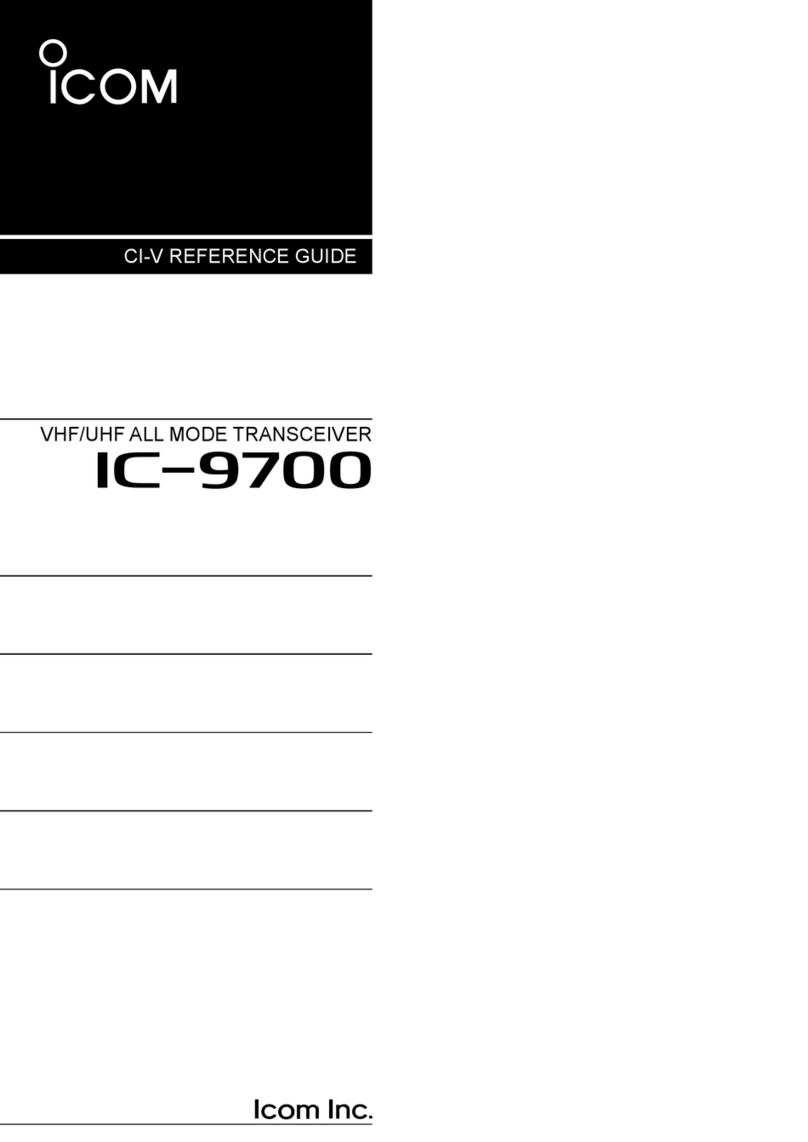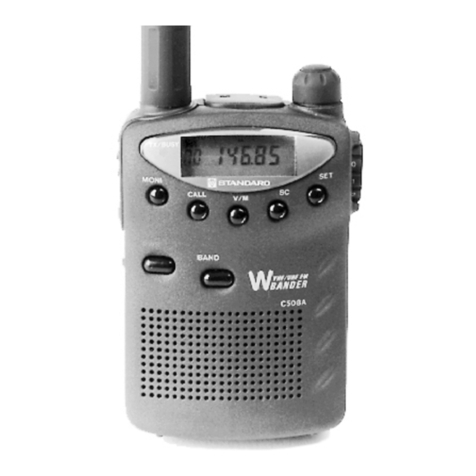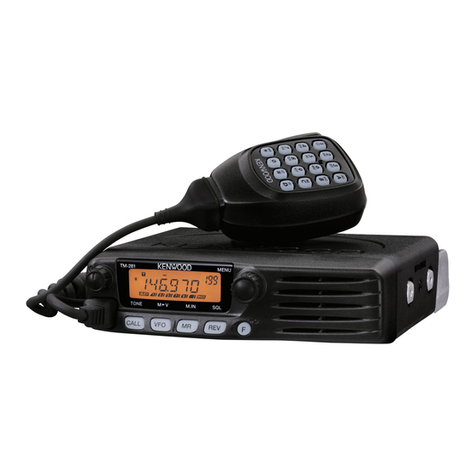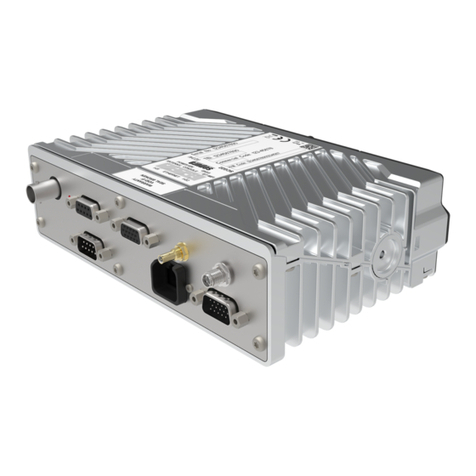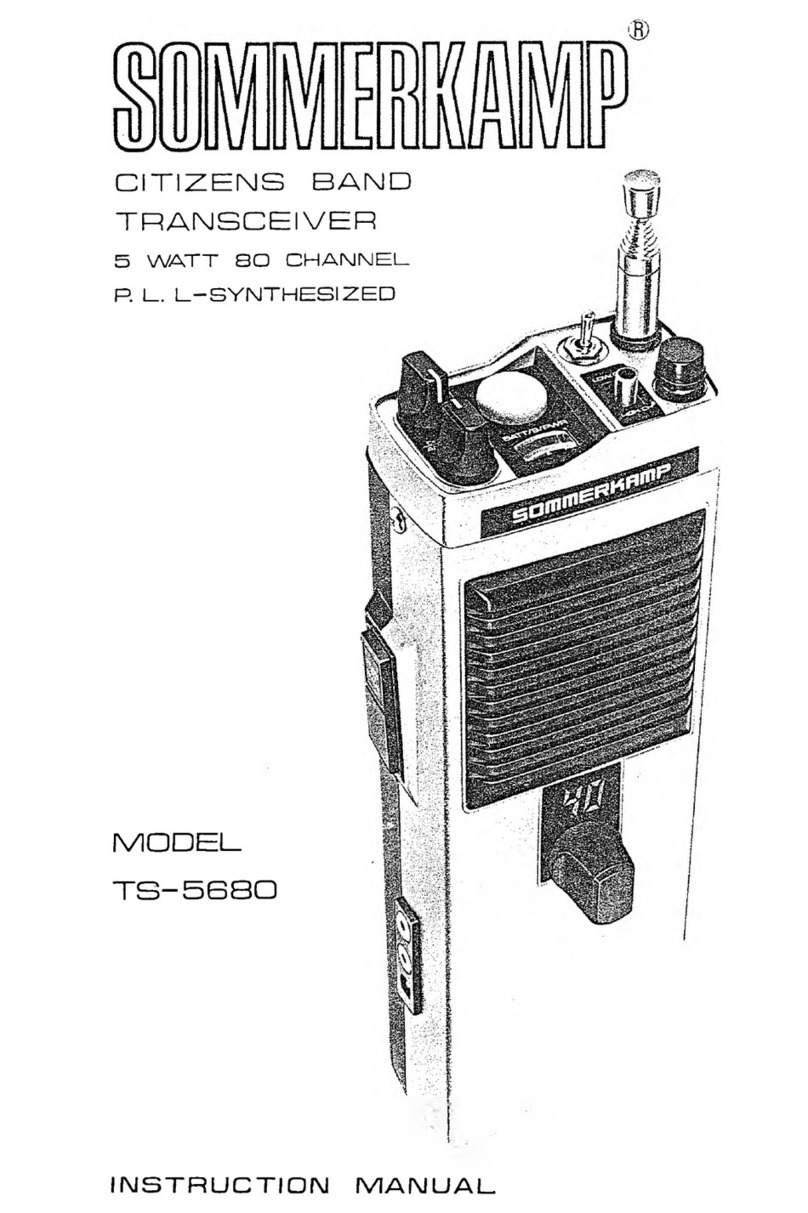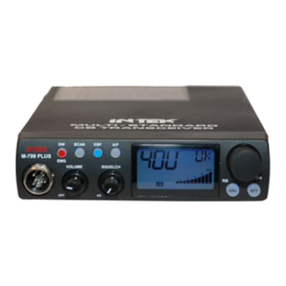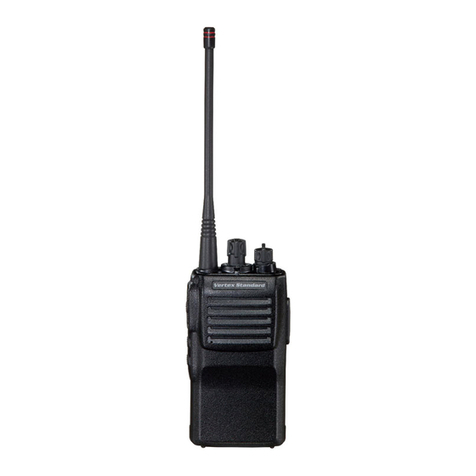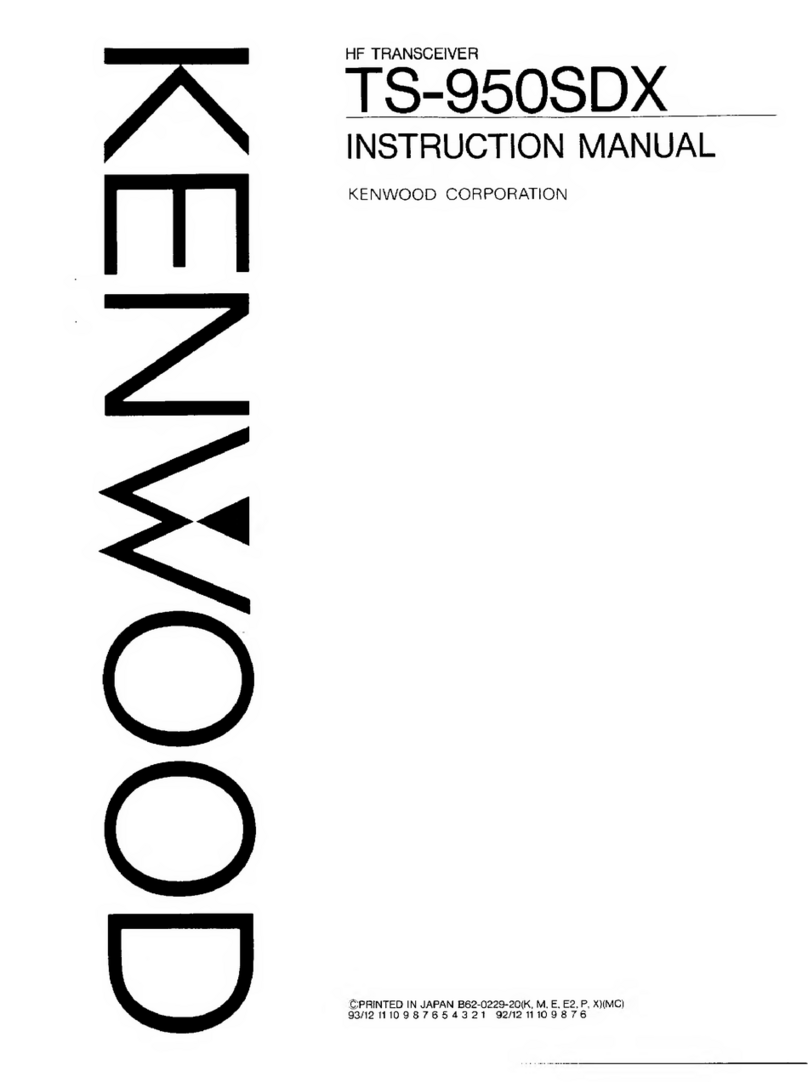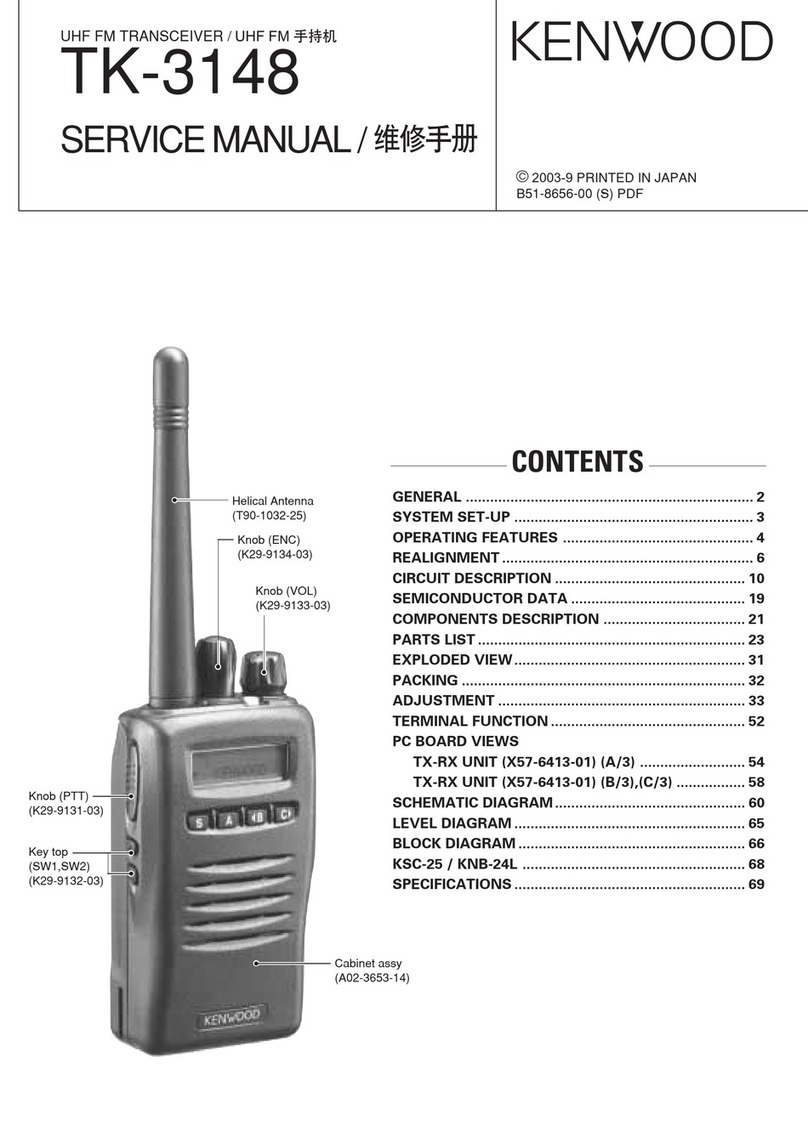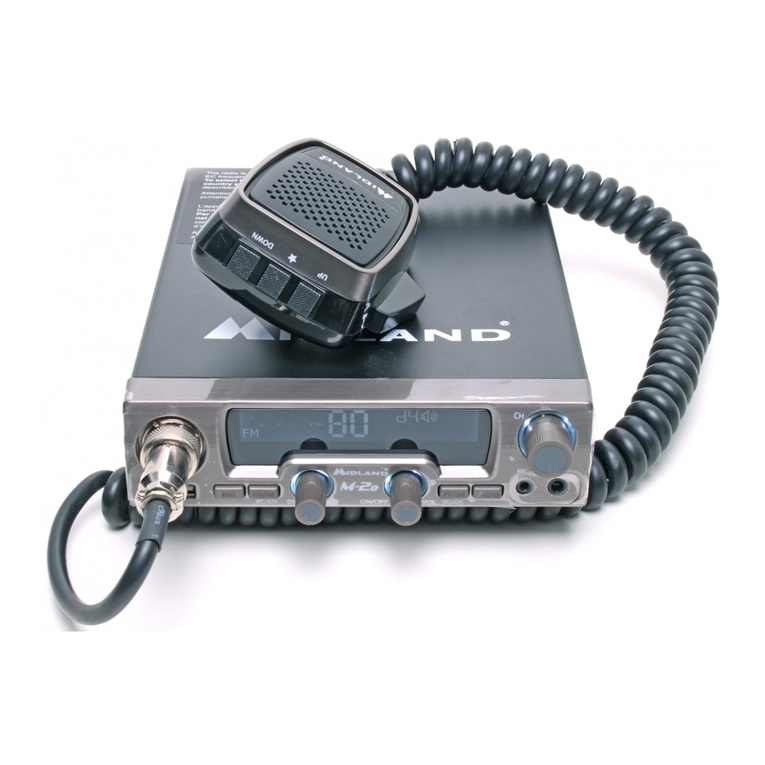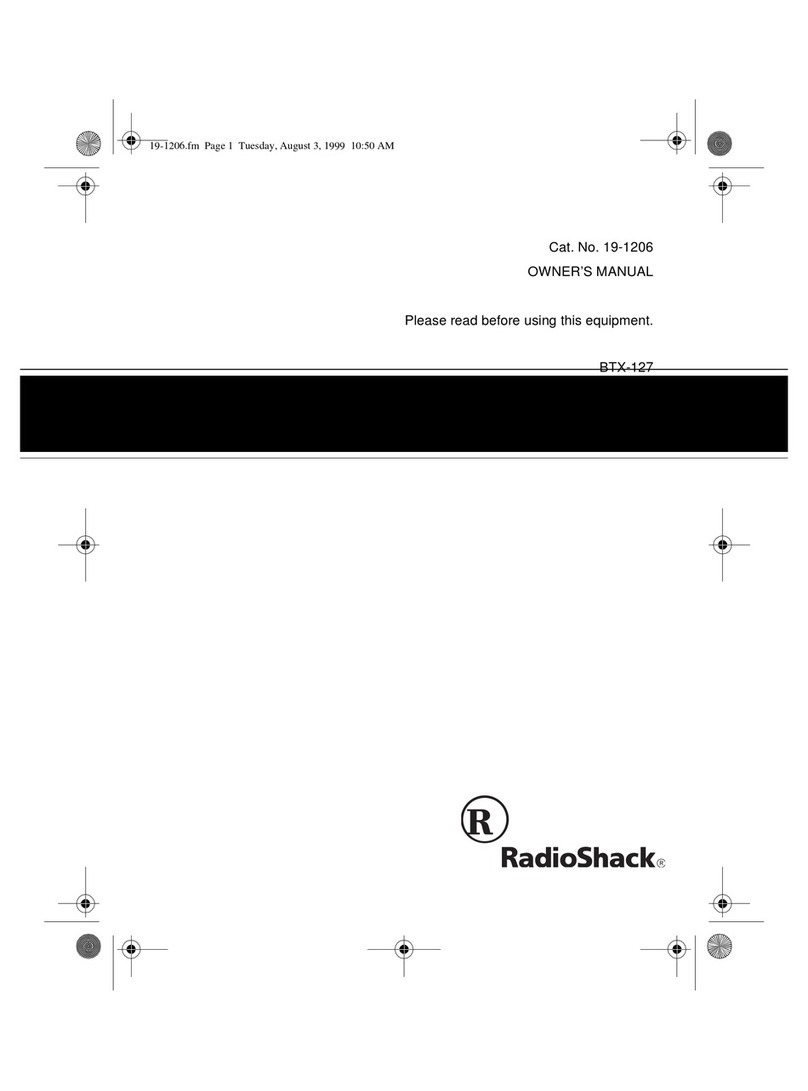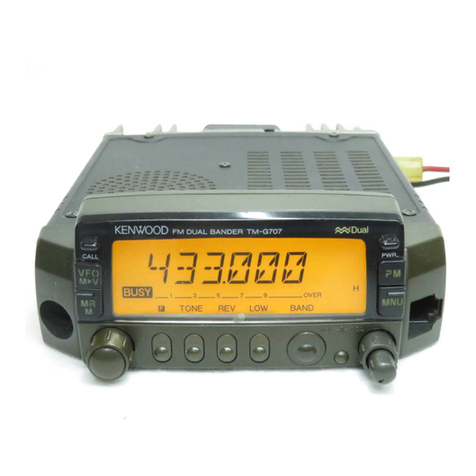Icom IC-M601 User manual

INSTRUCTION MANUAL
iM601
VHF MARINE TRANSCEIVER
查询M601供应商 捷多邦,专业PCB打样工厂
,24小时加急出货

i
FOREWORD
Thank you for purchasing this Icom product. The IC-
M601 V
HF MARINE TRANSCEIVER
is designed and built
with Icom’s state of the art technology and craftsman-
ship. With proper care, this product should provide you
with years of trouble-free operation.
We want to take a couple of moments of your time to
thank you for making the IC-M601 your radio of choice,
and hope you agree with Icom’s philosophy of “tech-
nology first.” Many hours of research and development
went into the design of your IC-M601.
D
FEATURES
❍Built-in DSC meets ITU Class D requirement
An independent receiver continuously watches Ch. 70,
while using another channel. Further, a single antenna
connector allows VHF and Ch. 70 operation, thus sim-
plifying installation. The 10-keypad allows simple and
efficient operation of the DSC emergency functions,
vital for your safety at sea.
❍Superior receiver performance
The IC-M601 has excellent receive specifications of more
than 75 dB for spurious response, and intermodulation
rejection. With such high level performance, received
calls are remarkably clear and free from noise. The pow-
erful audio output from the front facing speaker further
increases the clarity of received calls.
❍Optional COMMANDMIC
(2 systems are connectable)
The optional COMMANDMIC provides a 2nd and 3rd
station capability and an intercom function. With slim
dimension and sizable LCD, the COMMANDMIC offers
ease and convenience of operating the radio from
remote locations such as the cockpit or tower up to a
max. 21 m* from the IC-M601.
* Requires use of optional OPC-999 extension cables.
❍Large LCD with dot matrix characters
The large dot-matrix display is designed for optimum
readability in any lighting condition. With the extra large
font, the channel number is maximized on the display
and other information can be easily read.
❍Rugged waterproof construction
The IC-M601 including the supplied (HM-137)/optional
(HM-134) microphone has effective waterproofing
equivalent to JIS waterproof grade 7*.
* 1 m/30 min; except cables.

ii
Icom, Icom Inc. and the logo are registered trademarks
of Icom Incorporated (Japan) in the United states, the United
Kingdom, Germany, France, Spain, Russia and/or other coun-
tries.
IMPORTANT
READ THIS INSTRUCTION MANUAL
CAREFULLY before attempting to operate the trans-
ceiver.
SAVE THIS INSTRUCTION MANUAL. This
manual contains important safety and operating in-
structions for the IC-M601.
EXPLICIT DEFINITIONS
CLEAN THE TRANSCEIVER AND MICROPHONE
THOROUGHLY WITH FRESH WATER after exposure to
water including salt water, otherwise, the keys and
switches may become inoperable due to salt crystallization.
WORD DEFINITION
RRWARNING Personal injury, fire hazard or electric
shock may occur.
CAUTION Equipment damage may occur.
NOTE
If disregarded, inconvenience only. No
risk or personal injury, fire or electric
shock.
Versions of the IC-M601 which display the “CE”
symbol on the serial number seal, comply with the es-
sential requirements of the European Radio and
Telecommunication Terminal Directive 1999/5/EC.
This warning symbol indicates that this equip-
ment operates in non-harmonised frequency bands
and/or may be subject to licensing conditions in the
country of use. Be sure to check that you have the
correct version of this radio or the correct program-
ming of this radio, to comply with national licensing
requirements.

iii
If your vessel requires assistance, contact other vessels and
the Coast Guard by sending a distress call on Channel 16.
Or, transmit your distress call using digital selective calling on
Channel 70.
USING DIGITAL SELECTIVE CALLING (Ch 70)
DISTRESS CALL PROCEDURE
1. While lifting up the switch cover, push and
hold [DISTRESS] for 5 sec. until you hear 5
short beeps change to one long beep.
2. Wait for an acknowledgment from a coast
station.
• Channel 16 is automatically selected.
3. Push and hold [PTT], then transmit the
appropriate information as at left.
USING CHANNEL 16
DISTRESS CALL PROCEDURE
1. “MAYDAY MAYDAY MAYDAY.”
2. “THIS IS ...............” (name of vessel)
3. Your call sign or other indication of the
vessel (AND 9-digit DSC ID if you have one).
4. “LOCATED AT ...............” (your position)
5. The nature of the distress and assistance
required.
6. Any other information which might facilitate
the rescue.
IN CASE OF EMERGENCY

FOREWORD .............................................. i
IMPORTANT ............................................. ii
EXPLICIT DEFINITIONS ........................... ii
IN CASE OF EMERGENCY ..................... iii
TABLE OF CONTENTS ........................... iv
PRECAUTION .......................................... v
1 OPERATING RULES .................. 1
2 PANEL DESCRIPTION .......... 2 – 7
■Panel description ............................ 2
■Function display .............................. 6
■Microphone (HM-137)...................... 7
3 BASIC OPERATION ............ 8 – 12
■Channel selection ........................... 8
■Receiving and transmitting ........... 10
■Call channel programming ............ 11
■Channel comments ....................... 11
4 DUALWATCH/TRI-WATCH ....... 13
■Description .................................... 13
■Operation ...................................... 13
5 SCAN OPERATIONS ......... 14 – 15
■Scan types .................................... 14
■Setting tag channels ..................... 15
■Starting a scan .............................. 15
6 DSC OPERATION .............. 16 – 32
■MMSI code programming ............. 16
■Position and time programming .... 16
■Position indication ......................... 17
■Distress call .................................. 18
■Transmitting DSC calls ................. 19
■Setting the distress information .... 23
■DSC individual ID ......................... 24
■Receiving DSC calls ..................... 27
■DSC set mode .............................. 29
■Received messages ..................... 31
7 OTHER FUNCTIONS .......... 33–36
■Hailer operation ............................ 33
■Automatic foghorn ......................... 34
■Microphone lock function .............. 35
■Intercom operation ........................ 36
8 SET MODE ........................ 37 – 39
■Set mode programming ................ 37
■Set mode items ............................. 38
9 CONNECTIONS AND
MAINTENANCE ................. 40 – 44
■Supplied accessories .................... 40
■Antenna ........................................ 40
■Fuse replacement ......................... 40
■Cleaning ....................................... 40
■Connections .................................. 41
■Mounting the transceiver .............. 42
■Dimensions.................................... 44
10 TROUBLESHOOTING .............. 45
11 CHANNEL LIST ........................ 46
12 SPECIFICATIONS AND
OPTIONS .................................. 47
■Specifications ............................... 47
■Options ......................................... 47
13 HM-134 REMOTE-CONTROL
MICROPHONE ................... 48–58
■Panel description .......................... 48
■Function display ............................ 50
■Channel selection ......................... 52
■Receiving and transmitting ........... 53
■Lock functions ............................... 54
■Display backlighting ...................... 54
■Monitor function ............................ 54
■Call channel programming ............ 55
■Starting a scan .............................. 55
■Setting tag channels ..................... 56
■Dualwatch/Tri-watch operation ..... 56
■Set mode programming ................ 57
■Intercom operation ........................ 58
■Channel comments ....................... 58
14 HM-134 CONNECTIONS AND
INSTALLATION .................. 59–60
■HM-134 supplied accessories .......59
■Installation .....................................59
INSTALLATION NOTES
HM-134 TEMPLATE
iv
TABLE OF CONTENTS 1
2
3
4
5
6
7
8
9
10
11
12
14
13

v
RWARNING! NEVER connect the transceiver to an AC
outlet. This may pose a fire hazard or result in an electric
shock.
NEVER connect the transceiver to a power source of more
than 16 V DC or use reverse polarity. This will ruin the trans-
ceiver.
NEVER cut the DC power cable between the DC plug and
fuse holder. If an incorrect connection is made after cutting,
the transceiver may be damaged.
NEVER place the transceiver where normal operation of the
vessel may be hindered or where it could cause bodily injury.
KEEP the transceiver at least 1 m away from the ship’s nav-
igation compass.
DO NOT use or place the transceiver in areas with temper-
atures below –20°C or above +60°C or in areas subject to di-
rect sunlight, such as the dashboard.
AVOID the use of chemical agents such as benzine or al-
cohol when cleaning, as they may damage the transceiver
surfaces.
BE CAREFUL! The transceiver rear panel will become
hot when operating continuously for long periods.
Place the transceiver in a secure place to avoid inadvertent
use by children.
BE CAREFUL! The transceiver, HM-137 and optional
HM-134 employ waterproof construction, which corresponds
to JIS waterproof specification, Grade 7 (1 m/30 min.). How-
ever, once the transceiver or microphone has been dropped,
waterproofing cannot be guaranteed due to the fact that the
case may be cracked, or the waterproof seal damaged, etc.
PRECAUTION

1
1
OPERATING RULES
DDPRIORITIES
•Read all rules and regulations pertaining to priorities and
keep an up-to-date copy handy. Safety and distress calls
take priority over all others.
•You must monitor Channel 16 when you are not operating
on another channel.
• False or fraudulent distress signals are prohibited and pun-
ishable by law.
DDPRIVACY
• Information overheard but not intended for you cannot law-
fully be used in any way.
• Indecent or profane language is prohibited.
DDRADIO LICENSES
(1) SHIP STATION LICENSE
You must have a current radio station license before using the
transceiver. It is unlawful to operate a ship station which is not
licensed.
Inquire through your dealer or the appropriate government
agency for a Ship-Radiotelephone license application. This
government-issued license states the call sign which is your
craft’s identification for radio purposes.
(2) OPERATOR’S LICENSE
A Restricted Radiotelephone Operator Permit is the license
most often held by small vessel radio operators when a radio
is not required for safety purposes.
The Restricted Radiotelephone Operator Permit must be
posted or kept with the operator. Only a licensed radio opera-
tor may operate a transceiver.
However, non-licensed individuals may talk over a transceiver
if a licensed operator starts, supervises, ends the call and
makes the necessary log entries.
Keep a copy of the current government rules and regulations
handy.
1

PANEL DESCRIPTION
2
2
■Panel description
VOL
iM601
VHF MARINE
MIC
C
H/L
DIAL
16
SQL
DISTRESS
Speaker
MIC connector
Function
display
q
wertyu oi!0
!1
!2
(Connect
HM-137 ONLY)
CAUTION: NEVER connect
other microphones here, such as
the optional HM-134, may cause
damage to the transceiver.

qTRANSMIT POWER SWITCH [H/L]
➥Toggles high or low power when pushed. (p. 10)
• Some channels are set to low power only.
➥While pushing this switch, some switches perform sec-
ondary function.
wVOLUME CONTROL [VOL] (p. 10)
Adjusts the audio level.
eSQUELCH CONTROL [SQL] (p. 10)
Sets the squelch threshold level.
rDIAL SWITCH [DIAL] (p. 9)
➥Exits from Channel 16 or call channel when pushed mo-
mentarily. (p. 8)
➥While pushing [H/L], push to select one of 2 regular
channels in sequence. (p. 9)
•International and U.S.A. channels are available for regular
channels. (depends on version)
tCHANNEL SELECTOR [CHANNEL] (p. 10)
Rotate [CHANNEL] to select the operating channels, set
mode contents, etc.
yCHANNEL 16/CALL CHANNEL SWITCH [16•C]
➥Selects Channel 16 when pushed. (p. 8)
➥Selects call channel when pushed for 1 sec. (p. 8)
•“CALL” appears when call channel is selected.
➥Push for 3 sec. to enter call channel programming con-
dition when call channel is selected. (p. 11)
➥While pushing [H/L], enters channel comment program-
ming condition. (p. 11)
➥While turning power ON, enters set mode when pushed
and held. (p. 37)
uPOWER SWITCH [POWER]
Push to turn the transceiver power ON or OFF.
iCLEAR SWITCH [CLR]
Push to cancel the entered function.
oDISTRESS SWITCH [DISTRESS] (p. 18)
Transmits distress call when pushed for 5 sec.
!0 FUNCTION SWITCH [F]
After pushing, activates the secondary functions.
• “F” appears when a secondary function can be accessed.
!1 DSC MENU SWITCH [MENU] (p. 16)
➥Toggles the DSC menu ON or OFF when pushed.
PANEL DESCRIPTION
3
2
2

4
2PANEL DESCRIPTION
!2 KEYPAD
➥Inputs numeral for channel number input, etc.
➥Inputs numeral and alphabet (some symbol) for channel
comment input.
➥After pushing [F], turns the secondary function ON or
OFF.
•[3 DIM] is necessary to rotate [CHANNEL] after pushing.
•Most of secondary function (except [5 TAG], [8 FOG]) can be
cleared or cancelled when push [CLR] (i).
➥Number input: ‘1’
➥Comment input: ‘1,’ ‘Q,’ ‘Z,’ ‘q,’ ‘z’ or space
➥After pushing [F], turns the DUALWATCH
function ON or OFF. (p. 13)
➥Number input: ‘2’
➥Comment input: ‘2,’ ‘A,’ ‘B,’ ‘C,’ ‘a,’ ‘b’ or ‘c’
➥After pushing [F], turns the TRI-WATCH func-
tion ON or OFF. (p. 13)
➥Number input: ‘3’
➥Comment input: ‘3,’ ‘D,’ ‘E,’ ‘F,’ ‘d,’ ‘e’ or ‘f’
➥After pushing [F], push this switch and rotate
[CHANNEL] to adjust the brightness of the
LCD and switch backlight.
➥Number input: ‘4’
➥Comment input ‘4,’ ‘G,’ ‘H,’ ‘I,’ ‘g,’ ‘h’ or ‘i’
➥After pushing [F], starts or stops the SCAN
function. (p. 15)

5
2
PANEL DESCRIPTION
➥Number input: ‘5’
➥Comment input: ‘5,’ ‘J,’ ‘K,’ ‘L,’ ‘j,’ ‘k’ or ‘l’
➥After pushing [F], sets the displayed channel
as a tag (scanned) channel. (p.15)
➥While pushing [H/L], push for 3 sec. to clear all
tag channels. (p.15)
➥Number input: ‘6’
➥Comment input: ‘6,’ ‘M,’ ‘N,’ ‘O,’ ‘m,’ ‘n’ or ‘o’
➥No secondary function
➥Number input: ‘7’
➥Comment input: ‘7,’ ‘P,’ ‘R,’ ‘S,’ ‘p,’ ‘r’ or ‘s’
➥After pushing [F], turns the HAILER function
ON or OFF. (p. 33)
➥Number input: ‘8’
➥Comment input: ‘8,’ ‘T,’ ‘U,’ ‘V,’ ‘t,’ ‘u’ or ‘v’
➥After pushing [F], turns the AUTOMATIC
FOGHORN function ON or OFF. (p. 34)
➥Number input: ‘9’
➥Comment input: ‘9,’ ‘W,’ ‘X,’ ‘Y,’ ‘w,’ ‘x’ or ‘y’
➥After pushing [F], turns the INTERCOM func-
tion ON or OFF. (p. 36)
➥Number input: ‘0’
➥Number input: Push for 1 sec. to edit ‘A.’
• Inputing “A” for simplex channels.
➥Comment input: ‘0’ and symbols (‘–’ ‘/’ ‘.’)
➥No secondary function
Fixes input of channel number and channel com-
ment, etc.
Clears entered digits and retrieves the previous
channel or channel comment during setting.
2

■Function display
qBUSY/TRANSMIT INDICATOR (p. 10)
➥“BUSY” appears when receiving a signal or when the
squelch opens.
➥“TX” appears while transmitting.
wTAG CHANNEL INDICATOR (p. 15)
Appears when a tag channel is selected.
eSCAN INDICATOR
➥Either “NORMAL SCAN” or “PRI-SCAN 16” scan
type appears while scanning. (p. 15)
➥“DUAL 16” appears during dualwatch; “TRI 16” ap-
pears during tri-watch. (p. 13)
rPOSITION INDICATOR
➥Shows the GPS position data.
•“??” may blink every 2 sec. instead of position data; when the
GPS position data is invalid. In such a case, the last position
data is held for up to 23.5 hours.
•“??” may blink every 2 sec. instead of position data 4 hours
after the position data is input manually, up until 23.5 hours
have past.
➥“No Position” appears when no GPS receiver is
connected and no position data is input manually.
tTIME ZONE INDICATOR
➥“Local” appears when the offset time data in the ‘Set
up’ menu is entered. (p. 29)
➥“No Time” appears when no GPS receiver is con-
nected and no time data is input manually.
BUSY-5W---INT---CALL
LOCAL--DUP
SCRAM--TAG
NORMAL-SCAN
-34"34.506N
1 3" 3. 36W
Local--1:10--CALLING
q
w
r
t
e
!1 !0 oi
u
y
PANEL DESCRIPTION
6
2

7
2
PANEL DESCRIPTION
■Microphone (HM-137)
qPTT SWITCH [PTT] (p. 10)
Push and hold to transmit; release to receive.
wCHANNEL UP/DOWN SWITCHES [YY]/[ZZ](p. 10)
Push either switch to change the operating channel, set
mode contents, etc.
eCHANNEL 16/CALL CHANNEL SWITCH [16/C]
➥Push to select Channel 16; push for 1 sec. to Channel 9.
(p. 8)
➥
While pushing [16/C], turn power ON to toggle the lock
function ON or OFF. (p. 35)
Speaker
Microphone
w
q
e
16/C
yCHANNEL COMMENT INDICATOR
➥Channel comment appears if programmed. (p. 11)
➥“Low Batt” flashes when the battery voltage drops to
approx. 10 V DC or below.
uCHANNEL NUMBER READOUT
Indicates the selected operating channel number.
•“A” appears when a simplex channel is selected. (p. 9)
•“F” appears when [F] is pushed.
iCALL CHANNEL INDICATOR (p. 8)
“CALL” appears when the call channel is selected.
oCHANNEL GROUP INDICATOR (p. 9)
Indicates whether an International “INT” or U.S.A. “USA”
channel is selected. (depends on version)
!0 DUPLEX INDICATOR (p. 9)
Appears when a duplex channel is selected.
• Duplex channel has a different transmit frequency and receiving
frequency.
!1 POWER INDICATOR (p. 10)
➥“5W” appears when high power is selected.
➥“1W” appears when low power is selected.
2

8
3BASIC OPERATION
■Channel selection
DDChannel 16
Channel 16 is the distress and safety channel. It is used for
establishing initial contact with another station and for emer-
gency communications. Channel 16 is monitored during both
dualwatch and tri-watch. While standing by, you must monitor
Channel 16.
➥Push [16•C] momentarily to select Channel 16.
➥Push [DIAL] to return to the condition before selecting
Channel 16, or rotate [CHANNEL] to select operating chan-
nel.
DDCall channel
Each regular channel group has a separate leisure-use call
channel. The call channel is monitored during tri-watch. The
call channels can be programmed (p. 11) and are used to
store your most often used channels in each channel group
for quick recall.
➥Push [16•C] for 1 sec. to select the call channel of the se-
lected channel group.
•“CALL” and call channel number appear.
• Each channel group may have an independent call channel after
programming a call channel.
➥Push [DIAL] to return to the condition before selecting the
call channel,or rotate [CHANNEL] to select an operating
channel.
Push for
1 sec.
C
16
BUSY-5W---INT---CALL
LOCAL--DUP
SCRAM--TAG
NORMAL-SCAN
-34"34. 06N
1 3" 3. 36W
--UTC-10:10--CALLING
Push
C
16
BUSY-5W---INT---CALL
LOCAL--DUP
SCRAM--TAG
NORMAL-SCAN
-34"34. 06N
1 3" 3. 36W
--UTC-10:10--CALLING

3
BASIC OPERATION
9
DDU.S.A. channels (
depends on version)
and International channels
There are 58 U.S.A. channels in addition to 57 International
channels. These channel groups may be specified for the op-
erating area.
qPush [DIAL] to select a regular channel.
wWhile pushing [H/L], push [DIAL] to change the channel
group, if necessary.
• U.S.A. and International (INT) channels can be selected in se-
quence.
eRotate [CHANNEL] to select a channel.
•“DUP” appears for duplex channels.
• “A” appears for simplex channels.
Push +
U.S.A. channels
H/L DIAL
International channels
INT
DUP
USA
3

■Receiving and transmitting
CAUTION: Transmitting without an antenna may dam-
age the transceiver.
qPush [POWER] to turn power ON.
wSet the audio and squelch levels.
➥Rotate [SQL] fully counterclockwise in advance.
➥Rotate [VOL] to adjust the audio output level.
➥Rotate [SQL] clockwise until the noise disappears.
eTo change the channel group, push [DIAL] while pushing
[H/L]. (p. 9)
rRotate [CHANNEL] or push [Y]/[Z] on the microphone to
select the desired channel.
• When receiving a signal, “BUSY” appears and audio is emitted
from the speaker.
• Further adjustment of [VOL] may be necessary at this point.
tPush [H/L] to select the output power if necessary.
•“ 5W” or “1W” appears when high or low power is selected, re-
spectively.
•Choose low power to reduce an intermodulation for other sta-
tions, choose high power for longer distance communications.
• Some channels are for low power only.
yPush and hold [PTT] to transmit, then speak into the mi-
crophone.
•“TX” appears.
• Channel 70 cannot be used for transmission.
uRelease [PTT] to receive.
IMPORTANT: To maximize the readability of your trans-
mitted signal, pause a few sec. after pushing [PTT], hold
the microphone 2.5 to 5 cm from your mouth and speak at
a normal voice level.
VOL
iM601
VHF MARINE
MIC
C
SQL
16/C
w
e
qrr
tyu
3BASIC OPERATION
10

3
BASIC OPERATION
11
■Call channel programming
The call channel is used to select Channel 9, however, you
can program your most often-used channel in each channel
group for quick recall.
qWhile pushing [H/L], push [DIAL] once or twice to select
the desired channel group (U.S.A. and International) to be
programmed. (depends on version)
wPush [16•C] for 1 sec. to select the call channel of the se-
lected channel group.
•“CALL” and call channel number appear.
ePush [16•C] again for 3 sec. (until a long beep changes to
2 short beeps) to enter call
channel programming con-
dition.
•Channel number starts blink-
ing.
rRotate [CHANNEL] to se-
lect the desired channel.
tPush [16•C] to program the
displayed channel as the
call channel.
• Push [DIAL] to cancel.
•The channel number stops
blinking.
■Channel comments
Memory channels can be tagged with alphanumeric names
of up to 10 characters each.
Capital letters, small letters, numerals, some symbols (- ./)
and space can be used.
qSelect the desired memory channel.
• Cancel dual watch, tri-watch or scan in advance. (Push [CLR])
wWhile pushing [H/L], push [16•C] to edit the channel com-
ment.
•A cursor appears and blinks.
ePush the appropriate key several times to enter the de-
sired character.
• See the table on page 12 for available characters.
• Rotate [CHANNEL] or push [Y]/[Z] on the microphone to move
the cursor.
rPush [ENT] to input and set the comment.
• Push [CLR] to cancel.
• The cursor disappears.
tRepeat steps qto rto program other channel com-
ments, if desired.
BUSYBUSY-5W5W------INTINT------CALLCALL
LOCAL--DUPLOCAL--DUP
SCRAMSCRAM----TAGTAG
NORMAL-SCANNORMAL-SCAN
-34"34. 06N34"34. 06N
1 3" 3. 36W1 3" 3. 36W
----UTCUTC-10:1010:10----CALLINGCALLING
BUSYBUSY-5W5W------INTINT------CALLCALL
LOCAL--LOCAL--DUPDUP
SCRAMSCRAM----TAGTAG
NORMAL-SCANNORMAL-SCAN
-34"34. 06N34"34. 06N
1 3" 3. 36W1 3" 3. 36W
----UTCUTC-10:1010:10------INTLINTL
BUSY-BUSY- 5W5W------INTINT------CALLCALL
LOCAL--LOCAL--DUPDUP
SCRAMSCRAM----TAGTAG
NORMAL-SCANNORMAL-SCAN
-34"34. 06N34"34. 06N
1 3" 3. 36W1 3" 3. 36W
----UTCUTC-10:1010:10-PLEASURELEASURE
3

12
3BASIC OPERATION
KEY CHARACTERS KEY CHARACTERS
1
2
3
4
5
Q
A
D
G
J
Z
B
E
H
K
q
C
F
I
L
z(space)
a
d
g
j
b
e
h
k
c
i
l
6
7
8
9
0
M
P
T
W
-
N
R
U
X
/
O
S
V
Y
.
mno
p
t
w
r
u
x
s
v
y
• Available characters

13
4
DUAL WATCH/TRI-WATCH
■Description
Dualwatch monitors Channel 16 while you are receiving an-
other channel; tri-watch monitors Channel 16 and the call
channel while receiving another channel.
■Operation
qSelect the desired operating channel.
wPush [F], then push [1 DUAL] to start dualwatch or [2 TRI]
to start tri-watch.
•“DUAL” appears during dualwatch; “TRI” appears during tri-
watch.
• A beep tone sounds when a signal is received on Channel 16.
eTo cancel dualwatch or tri-watch, push [CLR] or repeat
step w.
[Example]: Operating tri-watch on INT channel 25.
DUALWATCH/TRI-WATCH SIMULATION
• If a signal is received on Channel 16, dualwatch/tri-watch pauses
on Channel 16 until the signal disappears.
•If a signal is received on the call channel during tri-watch, tri-
watch becomes dualwatch until the signal disappears.
•To transmit on the selected channel during dualwatch/tri-watch,
push and hold [PTT].
Call channel
Dualwatch Tri-watch
BUSY- 5W---INT---CALL
LOCAL--DUP
SCRAM--TAG
TRIMAL-SC16
-34"34. 06N
1 3" 3. 36W
--UTC-10:10-TELEPHONE
BUSY- 5W---INT---CALL
LOCAL--DUP
SCRAM--TAG
TRIMAL-SC16
-34"34. 06N
1 3" 3. 36W
--UTC-10:10-TELEPHONE
BUSY-5W---INT---CALL
LOCAL--DUP
SCRAM--TAG
TRIMAL-SC16
-34"34. 06N
1 3" 3. 36W
--UTC-10:10-TELEPHONE
BUSY-5W---INT---CALL
LOCAL--DUP
SCRAM--TAG
TRIMAL-SC16
-34"34. 06N
1 3" 3. 36W
--UTC-10:10--CALLING
Tri-watch starts.
Signal is received
on call channel.
Signal received on
Channel 16 takes
priority.
Tri-watch resumes
after the signal
disappears.
4
3

5SCAN OPERATIONS
14
■Scan types
Scanning is an efficient way to locate signals quickly over a
wide frequency range. The transceiver has priority scan and
normal scan.
Set the tag channels (scanned channel) before scanning.
Clear the tag channels which inconveniently stop scanning,
such as those for digital communication use. (Refer to right
page for details.)
Choose priority or normal scan in set mode. (p. 38)
NORMAL SCAN
Normal scan, like priority scan, searches through all tag
channels in sequence. However, unlike priority scan, Chan-
nel 16 is not checked unless Channel 16 is set as a tag
channel.
CH 01 CH 02
CH 06
CH 05 CH 04
CH 03
PRIORITY SCAN
Priority scan searches through all tag channels in se-
quence while monitoring Channel 16. When a signal is de-
tected on Channel 16, scan pauses until the signal disap-
pears; when a signal is detected on a channel other than
Channel 16, scan becomes dualwatch until the signal dis-
appears.
CH 06
CH 01
CH 16
CH 02
CH 05 CH 04
CH 03
Other Icom Transceiver manuals
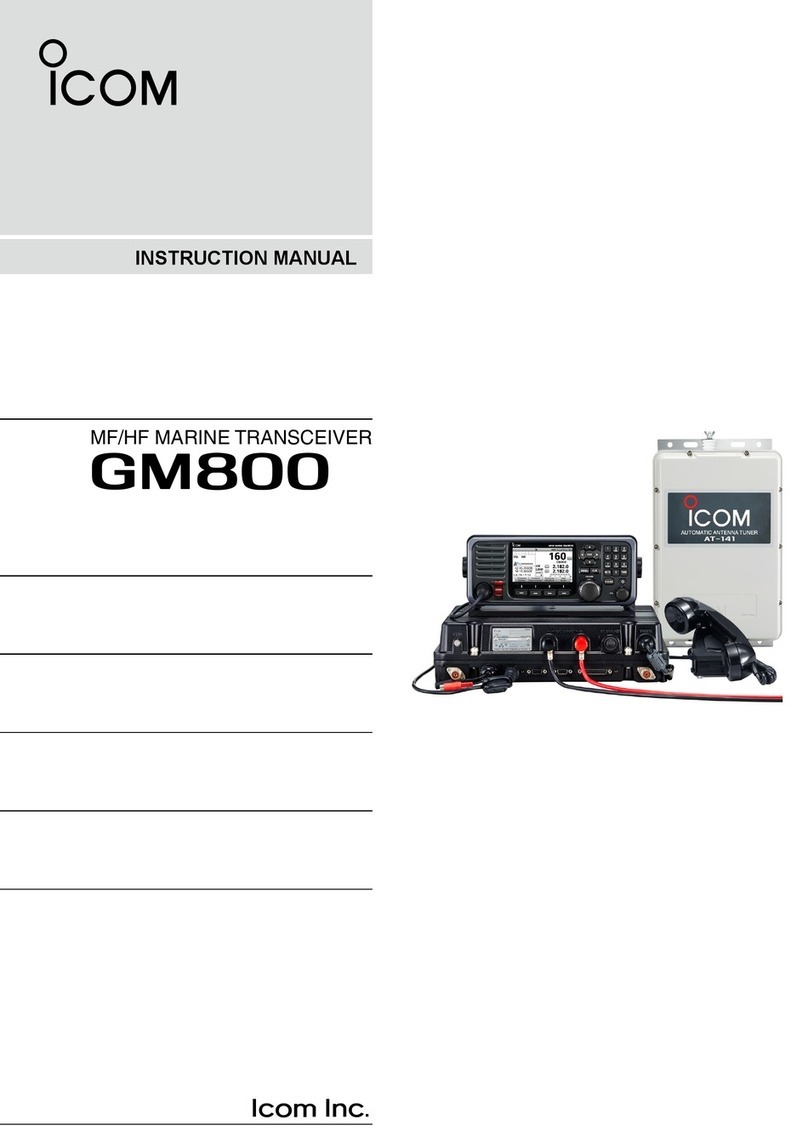
Icom
Icom IC-GM800 User manual
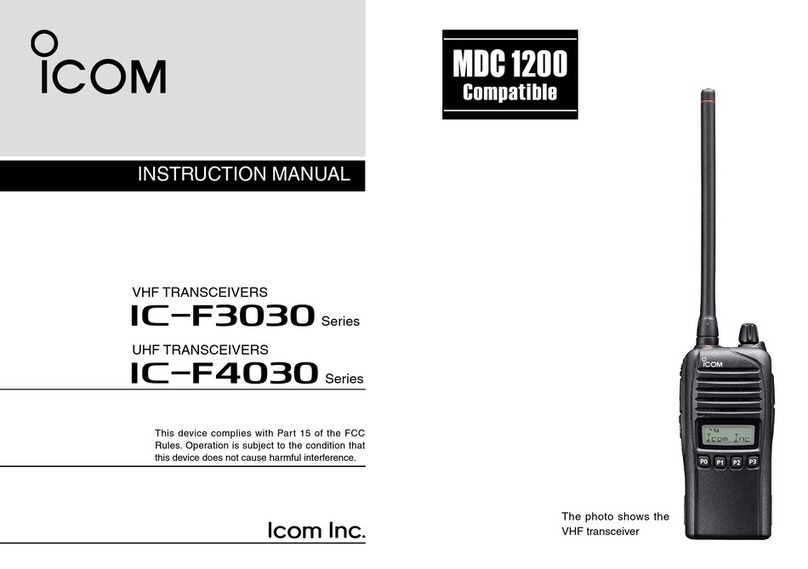
Icom
Icom IC-F3030 Series User manual

Icom
Icom IC-2100H User manual

Icom
Icom IC-F80DS User manual
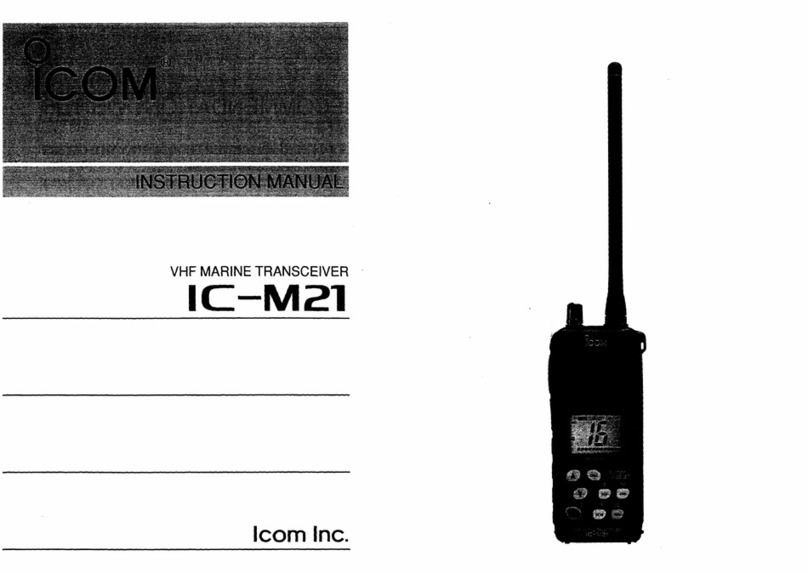
Icom
Icom IC-M21 User manual
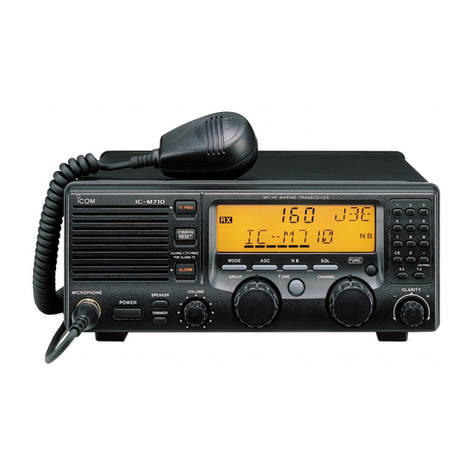
Icom
Icom IC-M710 User manual
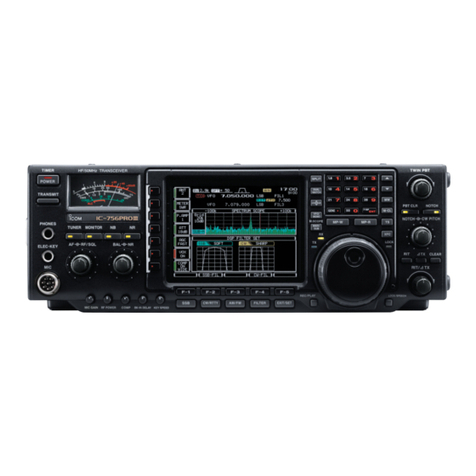
Icom
Icom IC-756PRO III User manual
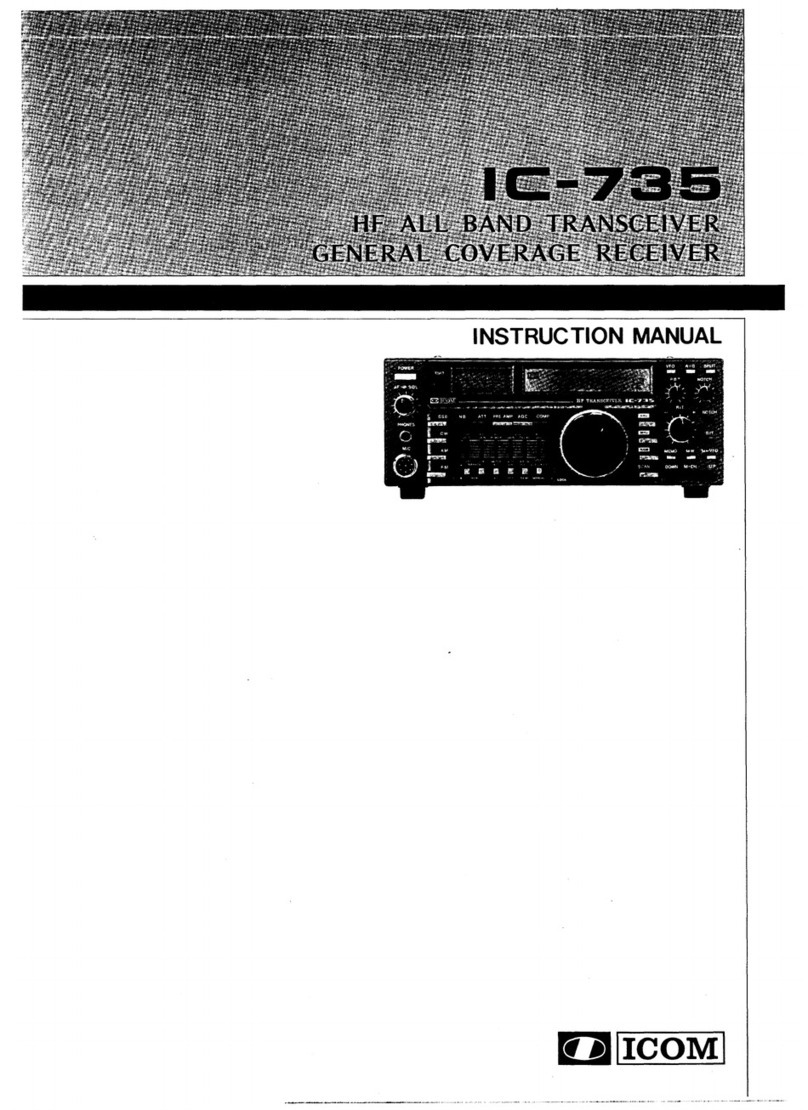
Icom
Icom IC-735 User manual
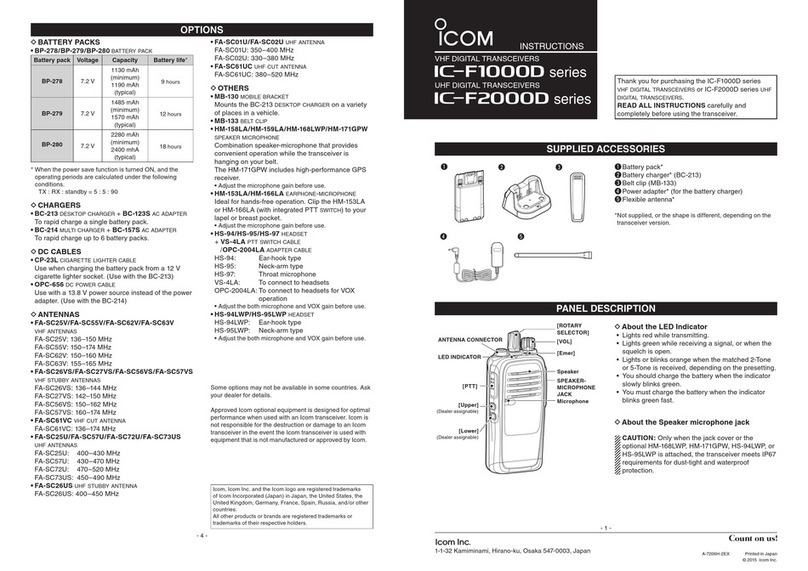
Icom
Icom ic-f1000d series User manual
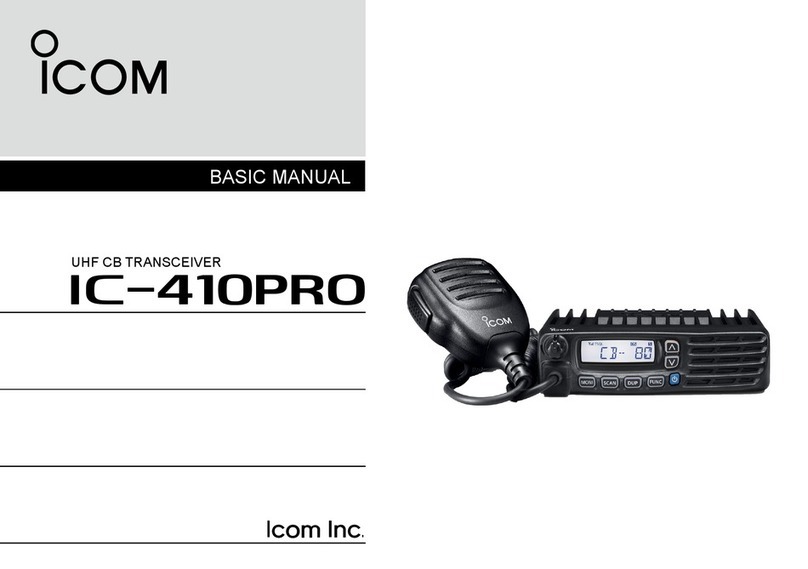
Icom
Icom IC-410PRO Installation guide
